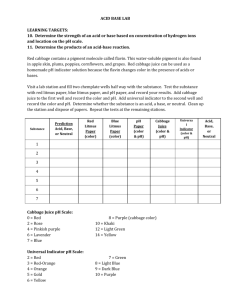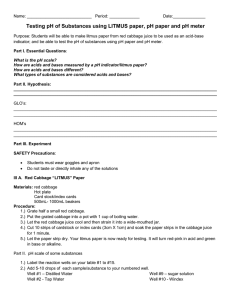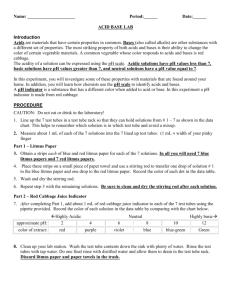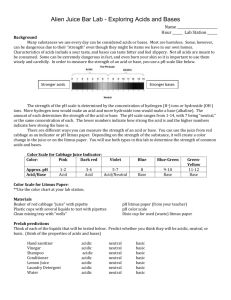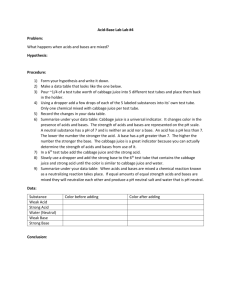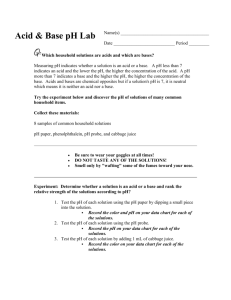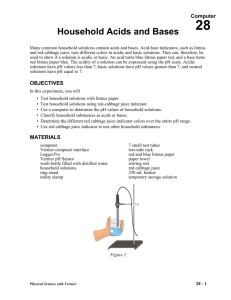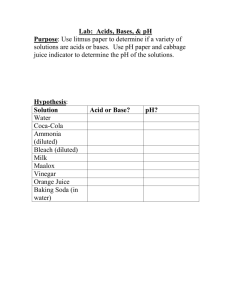Household Acids & Bases Lab
advertisement
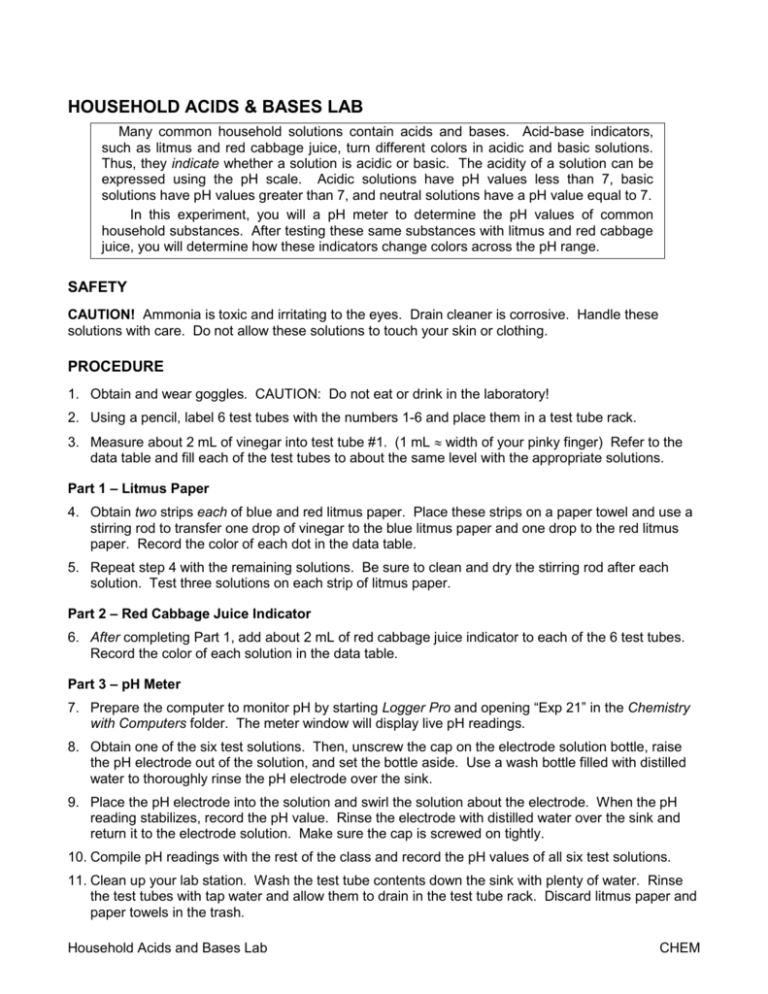
HOUSEHOLD ACIDS & BASES LAB Many common household solutions contain acids and bases. Acid-base indicators, such as litmus and red cabbage juice, turn different colors in acidic and basic solutions. Thus, they indicate whether a solution is acidic or basic. The acidity of a solution can be expressed using the pH scale. Acidic solutions have pH values less than 7, basic solutions have pH values greater than 7, and neutral solutions have a pH value equal to 7. In this experiment, you will a pH meter to determine the pH values of common household substances. After testing these same substances with litmus and red cabbage juice, you will determine how these indicators change colors across the pH range. SAFETY CAUTION! Ammonia is toxic and irritating to the eyes. Drain cleaner is corrosive. Handle these solutions with care. Do not allow these solutions to touch your skin or clothing. PROCEDURE 1. Obtain and wear goggles. CAUTION: Do not eat or drink in the laboratory! 2. Using a pencil, label 6 test tubes with the numbers 1-6 and place them in a test tube rack. 3. Measure about 2 mL of vinegar into test tube #1. (1 mL width of your pinky finger) Refer to the data table and fill each of the test tubes to about the same level with the appropriate solutions. Part 1 – Litmus Paper 4. Obtain two strips each of blue and red litmus paper. Place these strips on a paper towel and use a stirring rod to transfer one drop of vinegar to the blue litmus paper and one drop to the red litmus paper. Record the color of each dot in the data table. 5. Repeat step 4 with the remaining solutions. Be sure to clean and dry the stirring rod after each solution. Test three solutions on each strip of litmus paper. Part 2 – Red Cabbage Juice Indicator 6. After completing Part 1, add about 2 mL of red cabbage juice indicator to each of the 6 test tubes. Record the color of each solution in the data table. Part 3 – pH Meter 7. Prepare the computer to monitor pH by starting Logger Pro and opening “Exp 21” in the Chemistry with Computers folder. The meter window will display live pH readings. 8. Obtain one of the six test solutions. Then, unscrew the cap on the electrode solution bottle, raise the pH electrode out of the solution, and set the bottle aside. Use a wash bottle filled with distilled water to thoroughly rinse the pH electrode over the sink. 9. Place the pH electrode into the solution and swirl the solution about the electrode. When the pH reading stabilizes, record the pH value. Rinse the electrode with distilled water over the sink and return it to the electrode solution. Make sure the cap is screwed on tightly. 10. Compile pH readings with the rest of the class and record the pH values of all six test solutions. 11. Clean up your lab station. Wash the test tube contents down the sink with plenty of water. Rinse the test tubes with tap water and allow them to drain in the test tube rack. Discard litmus paper and paper towels in the trash. Household Acids and Bases Lab CHEM OBSERVATIONS Create the following data table in your lab notebook. Test Tube Solution 1 vinegar 2 ammonia 3 lemon juice 4 soft drink 5 drain cleaner 6 baking soda solution Blue Litmus Red Litmus Red Cabbage Juice pH CONCLUSIONS Discuss the following questions in paragraph-form as if you were explaining the lab to an absent group member. Which of the household solutions are acids? Which are bases? How did you determine this? Describe how acids and bases affect the color of blue and red litmus. Describe how the color of the red cabbage juice indicator changes as you move from highly acidic to highly basic solutions. Note any color patterns that you observe. Discuss the advantages and disadvantages of litmus paper and red cabbage juice. Which indicator do you think is better? Household Acids and Bases Lab CHEM
